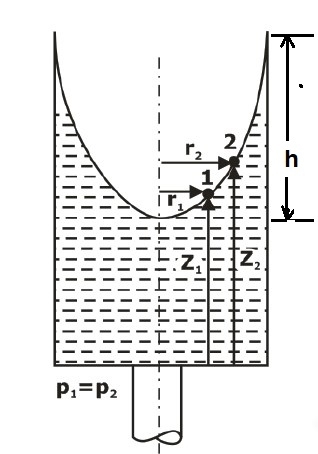Fluid Dynamics
Fluid Dynamics is the part of mechanics which deals with the motion of bodies and the action of forces that cause motion of the bodies.
Flow rate
- Mass flow rate

- Volume flow rate - Discharge
Generally, volume flow rate is also know as discharge and it is denoted by Q.
Continuity
As per mass conservation principle, "the matter neither can be created nor destroyed". It is applicable to the fluids to fixed volumes (control volumes or surfaces).
- Principle of conservation of mass for a control volume is given as:
Mass incoming per unit time = Mass outgoing per unit time + Increase in mass (in control volume per unit time).
- For steady flow: No mass increase within the control volume.
Mass incoming per unit time = Mass outgoing per unit time
Applying to a stream-tube:
Mass comes and exits only through the two ends (it cannot cross the stream tube wall).
For steady flow:
ρ1A1u1 = ρ2A2u2= Constant= Mass flow rate
This is the continuity equation.
For the incompressible flows: ρ = constant
A1u1 = A2u2
1. Some example applications of Continuity:

A liquid is flowing from left to right. By the continuity:
ρ1A1u1 = ρ2A2u2
As we are considering a liquid:ρ1=ρ2
2. Velocities in pipes coming from a junction:
Apply continuity equation at junction:
Mass inflow = Mass outflow
ρ1Q1= ρ2Q2 + ρ3Q3
When incompressible:
Q1 = Q2 + Q3
A1u1=A2u2 + A3u3
Energy Equations
- It is the equation of motion where the gravity and pressure forces are taken into consideration. The most common equations used in fluid dynamics are described below:
Let, Pressure force (Fp), Gravity force (Fg), Compressibility force (Fc), Viscous force (Fv), and Turbulent force (Ft).
Fnet = Fg + Fc +Fv + Fp + Ft
If fluid is incompressible, then: Fc = 0
∴ Fnet = Fg + Fv + Fp + Ft
This is known as Reynolds equation of motion.
For incompressible fluid with negligible turbulence: Fc = 0, Ft = 0
∴ Fnet = Fg + Fp + Fv
This equation is called as Navier-Stokes equation.
- For ideal fluid the viscous effect will be negligible. Thus:
Fnet = Fg + Fp
This equation is known as Euler’s equation.
- Euler’s equation can be written as:

Bernoulli’s Equation
It is the law of conservation of energy. This equation is applicable with the following assumptions:
- Flow is steady and irrotational.
- The fluid is ideal (non-viscous).
- The fluid is incompressible.
Statement: "For a steady, ideal flow incompressible fluid, the total energy of fluid at any point is constant". The total energy is the summation of pressure energy, kinetic energy, and potential energy. The energy terms in it are the per unit weight of the fluid.
Bernoulli equation is obtained from Euler's equation:

On integrating the above equation:


Limitation of Bernoulli’s equation:
- Flow is steady.
- Density is constant (incompressible).
- Friction losses are negligible.
- It is applicable at two points along a streamline, (not valid on two different streamlines).
The Bernoulli equation is applied along streamlines such as between points 1 and 2:

(Total head)1 = (Total head)2

Note Point: The Bernoulli equation and the continuity equation are combined to calculate velocities and pressures at different points in the flow connected by a streamline.
Momentum Equation
It is the conservation of momentum and states that the net force acting on a fluid mass is equal to the change in flow momentum per unit time in that direction.
F = m × a
![]() .......... (1)
.......... (1)
Equation (1) is the momentum principle equation.
F.dt = d(mv) .......... (2)
Equation (2) is known as the impulse-momentum equation. It defines that the impulse of a force (F) acting on a fluid of mass (m) in a short interval of time (dt) is equal to momentum change d(mv) in the direction of the force.
Applications:
1. Force produced by a flowing fluid on a pipe bend:
X- component of force:
![]()
Y- component of force:
![]()
Resultant Force (FR) is given by:
![]()
Resultant force direction with the horizontal is given by:
![]()
According to the moment of momentum principle:
As net resultant torque equals the rate of change of moment of momentum
![]()
This equation is called a moment of momentum equation and it can be applied for:
1. analysis of flow problems in hydraulic machines such as turbines and centrifugal pumps.
2. calculating torque exerted by water on the sprinkler.
Vortex Flow
It is the flow of a rotating mass of fluid or fluid flow along the curved path.

Free vortex flow
- No external torque or energy required. The fluid is under rotation due to certain energy previously given to them.
- In a free vortex mechanic, overall energy = constant i.e. there is no energy interaction between flow and external source or any loss of mechanical energy in the flow.
- Fluid chunk rotates because of the conservation of angular momentum.
- Velocity is inversely proportional to the radius.
- For a free vortex flow:
vr= constant
v= c/r - At the center of rotation i.e. at r = 0, velocity tends to be infinite, that point is known as a singular point.
- The free vortex flow is irrotational in nature, and also called the irrotational vortex.
- Bernoulli’s equation is applicable in a free vortex flow,
Examples: a river whirlpool, water outflow from a bathtub or a sink, fluid motion in the centrifugal pump at casing outlet, and flow around the circular pipe bend.
Forced vortex flow
- For the existence of forced vortex flow, there should be a continuous supply of energy or external torque.
- In forced vortex flow, all the fluid particles rotate at the constant angular velocity (ω) such as a solid body. Thus, forced vortex flow is considered as a solid body rotation.
- Tangential velocity is directly proportional to the radius.
- v = r ω
ω = Angular velocity.
r = Radius of rotation of fluid particles from the rotation axis.
- v = r ω
- The surface profile of vortex flow is parabolic.

Equation for forced vortex flow is given by:
- For forced vortex flow, total energy per unit weight increases with an increase of radius or rotation (r).
- Forced vortex is not irrotational, rather it is a rotational flow with constant vorticity 2ω.
Examples: A rotating vessel having a liquid with constant angular velocity (ω), flow inside the casing of a centrifugal pump.
Note:
In case of forced vortex:
Rise of liquid level at the ends = Fall of liquid level at the rotation axis.
i.e. Rise of liquid at the ends from O−O = Fall of liquid at the centre from O-O.

Thus, X = Y.
Kinetic Energy Correction Factor (α)
In a real fluid flowing over a solid surface or inside a pipe, the velocity will be zero at the solid boundary due to stick-slip phenomenon and will increase with the distance from the boundary. Thus, the kinetic energy per unit weight of the fluid will vary in a similar way.
The kinetic energy can be written in terms of average velocity V at any section and a kinetic energy correction factor (α) can be found by the relation:
Where m = ρAVdt and it is the total mass of the fluid flowing through cross-section during time dt.
By comparing the two equations for kinetic energy:
The value of α > 1 (always). Taking the kinetic energy correction factor (α), Bernoulli equation is written as:
Note Point: The factor α depends on the shape of the cross-section and the velocity distribution
No comments:
Post a Comment
Knowing brings controversy